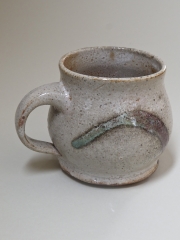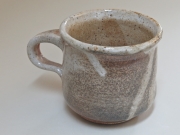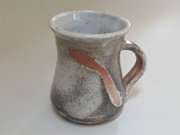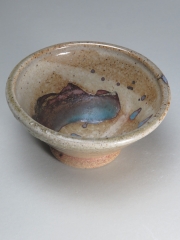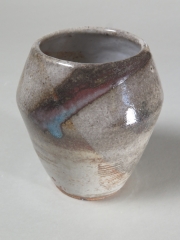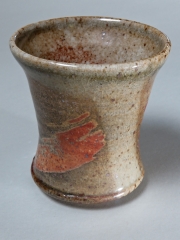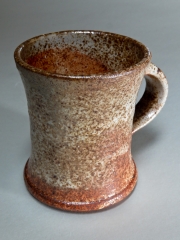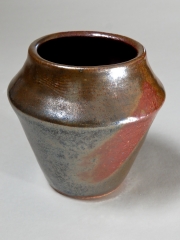An Exploration of Shino Glaze
 Shino glaze was first developed in Japan in the latter half of the sixteenth century. A Shino can go white, cream, orange, brown and black (even on a single piece). The use of this glaze is quite tricky. Many factors in the formulation, application, and firing of this glaze affect the final result. Shino glazes can produce very disappointing results and are prone to glaze faults such as crazing and crawling. However, with careful control of numerous variables, stunning results are possible. To further cloud the issue pieces treated in the same manner and fired at the same time in the same kiln can produce remarkably different results.
Shino glaze was first developed in Japan in the latter half of the sixteenth century. A Shino can go white, cream, orange, brown and black (even on a single piece). The use of this glaze is quite tricky. Many factors in the formulation, application, and firing of this glaze affect the final result. Shino glazes can produce very disappointing results and are prone to glaze faults such as crazing and crawling. However, with careful control of numerous variables, stunning results are possible. To further cloud the issue pieces treated in the same manner and fired at the same time in the same kiln can produce remarkably different results.
 At Coconino Community College under the tutelage of Don Fethkenher, we did an in-depth exploration of Shino glazes. We lived and breathed Shino for a month. Five of us made hundreds of pieces and tested these with different glaze formulations and different treatments and methods of application. We tried putting different Shino glazes over each other. We tried applying various chemicals over the glaze. We tried different methods of drying the ware once the glaze was applied. The list is much more extensive than mentioned here.
At Coconino Community College under the tutelage of Don Fethkenher, we did an in-depth exploration of Shino glazes. We lived and breathed Shino for a month. Five of us made hundreds of pieces and tested these with different glaze formulations and different treatments and methods of application. We tried putting different Shino glazes over each other. We tried applying various chemicals over the glaze. We tried different methods of drying the ware once the glaze was applied. The list is much more extensive than mentioned here.
 Having spent a semester studying this glaze, I feel I know Shino a lot better. As an analogy: I no longer feel like I am in kindergarten but am far from being an expert.
Having spent a semester studying this glaze, I feel I know Shino a lot better. As an analogy: I no longer feel like I am in kindergarten but am far from being an expert.
All the photos in this post are glazed with Shino (other glazes may be overlapped) and were made in June of 2016 (summer semester). As you can see, quite a variety of results are possible from Shino. The pieces shown in this post were selected from about 70 pieces I personally made.
Leopard Spot Shino (so called because of the dark spots) is particularly elusive and those who know its secret guard it carefully! The large image at the beginning of this post illustrates this glase. Carbon trapping (carbon is trapped in the glaze during firing) is essential for this particular result and is what causes the black areas. I am pleased to show an example of Leopard Spot Shino (no, I will not kiss and tell).
In addition to carbon trapping, the Shino glaze can under the proper conditions take on an opalescence that can be quite stunning. I have included a picture of this occurrence; unfortunately, the opalescence does not show well in the photograph. The piece has a beautiful metallic sheen.
